#but the folklore part may be unique in the philippines???
Explore tagged Tumblr posts
Text
Elders be like, "Don't talk to anyone in the woods. If you can't help it, just don't mention your name, don't also say yes or no to any of their questions, try to be vague with your answers, if you find the conversation suspicious, leave immediately. If they just appeared then disappeared, then they are powerful than most and already took your essence without you knowing..."
But me with the Elders be like, "Don't answer an unknown number. If you can't help it just don't mention your name. Don't say Yes or No because they will steal your voice to use AI and approve illegal bank transactions. If the caller is asking for complete bank account number, drop it already. Real banks don't do that. If you answer the call and it drops immediately, your data has already been taken."
For us, their tales were just folklores so we're not very scared of it. But for them, our tales are very real, and they see with their own eyes how we are scammed. I wonder what goes on in our seniors' minds when we warn them about the creepy dangers of technology, especially AI.
#not related#but the folklore part may be unique in the philippines???#though faes and enkantos are all around the world#so correct me if I'm wrong#dystopia#ai#dangers of technology#fae#fairy world#woods#the internet is out jungle#and AI is thr new type of cryptid
88 notes
·
View notes
Text
Discover the Enchantment: A Day Tour of Siquijor’s Hidden Gems
Nestled in the heart of the Philippines, Siquijor is often referred to as the “Island of Fire” for its mystical charm and enchanting beauty. Known for its pristine beaches, lush landscapes, and rich folklore, Siquijor offers a day tour experience that promises adventure, relaxation, and a touch of magic. If you’re seeking a quick yet memorable getaway, a day tour of Siquijor is the perfect way to immerse yourself in the island's captivating allure. In this guide, we’ll explore the highlights and hidden treasures of Siquijor, ensuring you make the most of your island adventure.
Morning Bliss: Start Your Day with a Beachside Sunrise
The best way to begin your day tour of Siquijor is with a serene sunrise on one of its beautiful beaches. Popular spots like Salagdoong Beach and Paliton Beach offer stunning early morning views where the sun gently kisses the horizon, casting a golden hue over the turquoise waters. The tranquil atmosphere is perfect for a moment of reflection or a leisurely walk along the shore.
Transitioning from the beach, indulge in a hearty breakfast at a local café. Many of these eateries offer fresh seafood and local delicacies, setting the stage for a day filled with island exploration. Enjoying a meal with a view of the crystal-clear waters is the ideal way to start your day, preparing you for the adventures that lie ahead.
A Journey Through Nature: Exploring Cambugahay Falls
After breakfast, set out to explore one of Siquijor’s most famous natural attractions—Cambugahay Falls. Located in the municipality of Lazi, this multi-tiered waterfall is a sight to behold. The falls cascade into turquoise pools, perfect for a refreshing dip after a scenic trek.
The journey to Cambugahay Falls involves a short hike through lush jungle terrain, which adds to the thrill of the adventure. As you approach the falls, the sound of rushing water grows louder, heightening the sense of anticipation. Once there, you can enjoy swimming in the cool, clear waters, or simply relax and take in the stunning surroundings. The natural beauty and peaceful ambiance of Cambugahay Falls make it a highlight of any day tour of Siquijor.
Mystical Wonders: Visit the Historic Siquijor Church
Next on your day tour of Siquijor is a visit to the historic Siquijor Church, formally known as the St. Francis of Assisi Church. This centuries-old church is one of the oldest in the Philippines and is a testament to the island’s rich history and cultural heritage.
The church’s architecture is a blend of Spanish colonial and local influences, with its impressive stone facade and intricate interior details. Inside, you’ll find beautiful wooden pews, antique statues, and vibrant stained glass windows. A visit to Siquijor Church offers a glimpse into the island’s past and provides a peaceful respite from your day’s activities. Take a moment to reflect and appreciate the historical significance of this revered site.
Enchanting Adventures: Discover the Magic of Siquijor’s Witchcraft
Siquijor is famously known for its mystical folklore and practices, and a visit to the island wouldn’t be complete without exploring its enchanting side. A stop at one of the local traditional healers or “albularyos” provides insight into the island’s unique spiritual practices.
Many locals practice traditional healing methods and have been passed down through generations. You can learn about the herbal remedies, charms, and rituals that form an integral part of Siquijor’s cultural fabric. While you may not experience any supernatural phenomena, the encounter with these local traditions adds an intriguing dimension to your day tour of Siquijor.
Relaxing Retreat: Unwind at the Majestic Paliton Beach
As the afternoon unfolds, head to Paliton Beach, renowned for its stunning natural beauty and serene environment. This beach is perfect for relaxation and unwinding after a day of exploration. Its powdery white sand and crystal-clear waters create a picturesque setting where you can enjoy a leisurely swim or simply bask in the sun.
Paliton Beach is less crowded compared to other tourist spots, offering a peaceful retreat where you can relax and take in the island’s beauty. The gentle waves and breathtaking scenery provide a perfect backdrop for reflecting on your day’s adventures and enjoying the tranquil island atmosphere.
Sunset Serenity: Conclude Your Day Tour with a Sunset View
No visit to Siquijor is complete without witnessing its breathtaking sunsets. As the day draws to a close, find a scenic spot on the beach or a hilltop vantage point to watch the sun dip below the horizon. The sunset hues of orange, pink, and purple create a magical ambiance that captures the essence of Siquijor’s allure.
Enjoy a leisurely evening as you reflect on the highlights of your day tour of Siquijor. Whether you’re savoring a delicious dinner at a seaside restaurant or simply taking in the view, the serene sunset offers a perfect ending to your island adventure.
Conclusion: Embrace the Magic of Siquijor
A day tour of Siquijor provides a snapshot of the island’s incredible beauty and mystical charm. From its stunning beaches and majestic waterfalls to its rich history and enchanting folklore, Siquijor offers an unforgettable experience for every traveler. Embrace the island’s magic, and let the natural wonders and cultural treasures leave a lasting impression on your heart.
Whether you’re seeking adventure, relaxation, or a touch of magic, Siquijor delivers it all in one extraordinary day. So pack your bags, set out on this enchanting journey, and create memories that will stay with you long after your visit.
0 notes
Text
Culture of the Philippines
The culture of the Philippines is characterized by cultural and ethnic diversity. Although the multiple ethnic groups of the Philippine archipelago have only recently established a shared Filipinonational identity, their cultures were all shaped by the geography and history of the region, and by centuries of interaction with neighboring cultures, and colonial powers. In more recent times, Filipino culture has also been influenced through its participation in the global community.
Ethnic groups of the Philippines
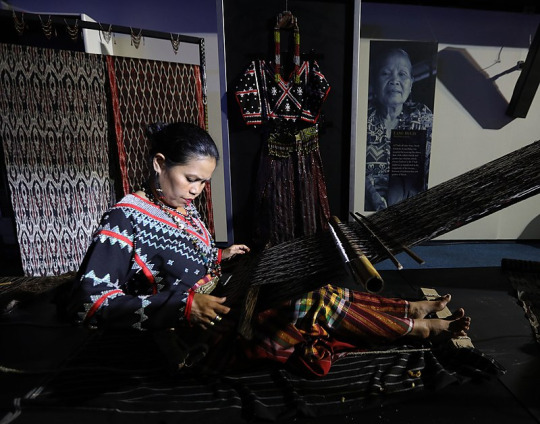
A Tboli woman weaving t'nalak from South Cotabato.
The Philippines is inhabited by more than 182 ethnolinguistic groups, many of which are classified as "Indigenous Peoples" under the country's Indigenous Peoples' Rights Act of 1997. Traditionally-Muslim peoples from the southernmost island group of Mindanao are usually categorized together as Moro peoples,
Architecture
Before the arrival of European colonizers, Austronesian architecture was the common form of housing on the archipelago.
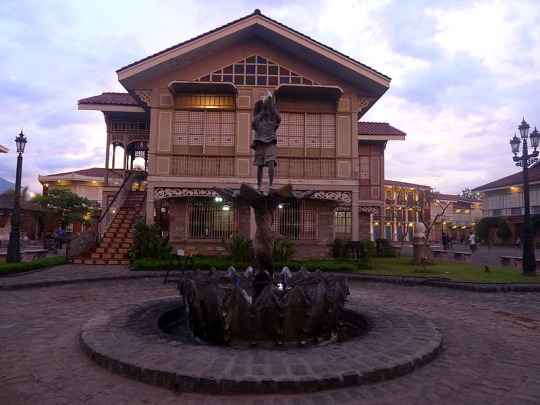
Bahay na bato, a traditional Filipino house
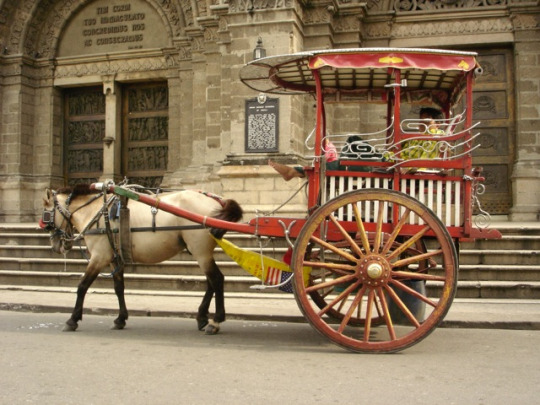
Kalesa, a traditional Philippine urban transportation, in front of Manila Cathedral entrance
During the Spanish era, the new Christianized lowland culture collectively evolved a new style known as the Nipa hut (Bahay Kubo). It is characterized by use of simple materials such as bamboo and coconut as the main sources of wood. Cogon grass, Nipa palm leaves and coconut fronds are used as roof thatching. Most primitive homes are built on stilts due to frequent flooding during the rainy seasons. Regional variations include the use of thicker, and denser roof thatching in mountain areas, or longer stilts on coastal areas particularly if the structure is built over water. The architecture of other indigenous peoples may be characterized by an angular wooden roofs, bamboo in place of leafy thatching and ornate wooden carvings. The Bahay na bato architecture is a variant of Nipa Hut that emerged during the Spanish era.
Traditional clothing
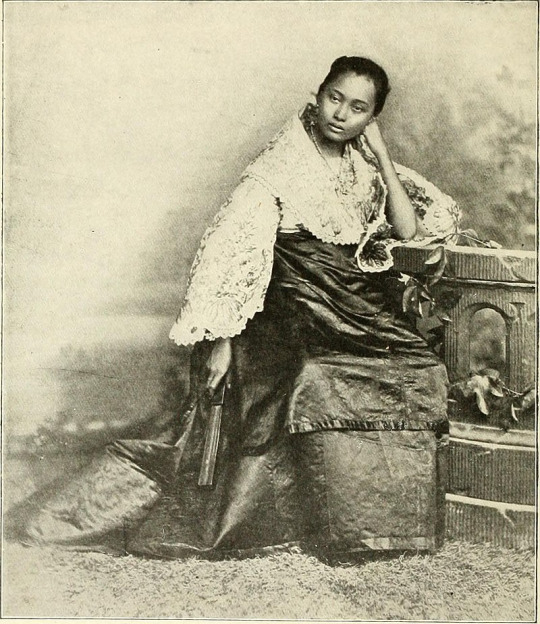
Filipina in traditional attire
Baro evolved from its forerunner garment worn by the Tagalogs of Luzon Prior to the Spanish Era. When the Spaniards came and settled into the islands, the fashion changed drastically as the Spanish culture influenced the succeeding centuries of Philippine history. The Spanish dissolved the kingdoms and united the country, resulting in a mixture of cultures from different ethnic groups of the conquered archipelago and Spanish culture. A new type of clothing called Barong tagalog (for men) and Baro't saya (for women) began to emerged and would ultimately define the newly formed Filipino culture....
Dancing

Filipino traditional dance at a festival
Philippine folk dances include the Tinikling and Cariñosa. In the southern region of Mindanao, Singkil is a popular dance showcasing the story of a prince and princess in the forest. Bamboo poles are arranged in a tic-tac-toe pattern in which the dancers exploit every position of these clashing poles
Music
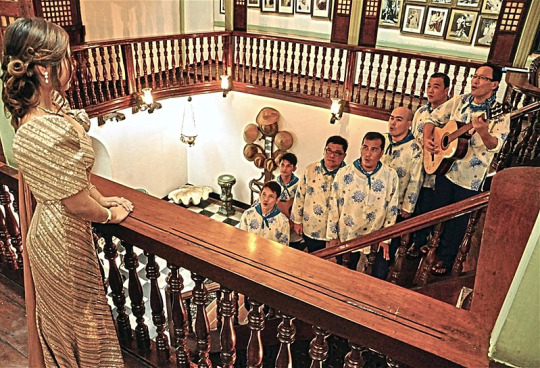
Harana (serenade)
The early music of the Philippines featured a mixture of Indigenous, Islamic and a variety of Asian sounds that flourished before the European and American colonization in the 16th and 20th centuries. Spanish settlers and Filipinos played a variety of musical instruments, including flutes, guitar, ukulele, violin, trumpets and drums. They performed songs and dances to celebrate festive occasions....
Folklore
Philippine mythologies are the first literature of the Philippines, usually passed on through generation via traditional and oral folk literature. Written texts recording the stories have also been made. These literary stories are mostly chanted as part of a dynamic Philippine epic poetry. While each unique ethnic group has its own stories and myths to tell, Hindu and Spanish influences can nonetheless be detected in many cases. Philippine mythology mostly consists of creation stories or stories about supernatural creatures, such as the aswang, the manananggal, the diwata/engkanto, and nature. Some popular figures from Philippine mythologies are Makiling, Lam-Ang, and the Sarimanok
Religion
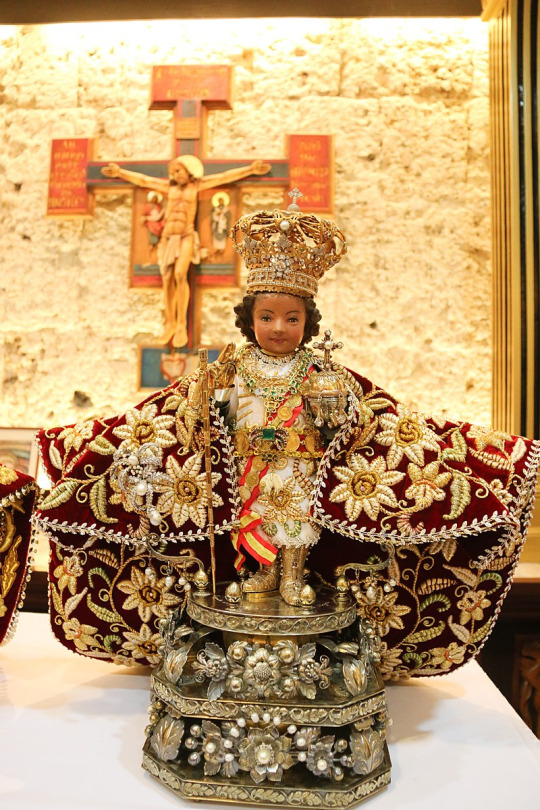
Original image of the Santo Niño de Cebú.
The arrival of the Spanish colonizers in the 16th century brought the beginning of the Christianization of the people in the Philippines. This phase in history is noted as the tipping point for the destruction of a variety of Anitist beliefs in the country, which were replaced by colonial belief systems that fitted the tastes of the Spanish, notably Christian beliefs. Christianity in form of has influenced Filipino culture in almost every facet, from visual arts, architecture, dance, and music. Presently, the Philippines is one of the two predominantly Catholic (80.58%) nations in Asia-Pacific, the other being East Timor. The country also has its own independent Philippine church, the Aglipayan, which accounts for around 2% of the national population. Other Christian churches are divided among a variety of Christian sects and cults. From the census in 2014, Christianity consisted of about 90.07% of the population and is largely present throughout the nation.....
Cuisine

Pancit canton
Filipinos cook a variety of foods influenced by of main Indian, Chinese, influences indigenous ingredients. The Spanish colonizers and friars in the 16th century brought with them produce from the Americas such as chili peppers, tomatoes, corn, potatoes, and the method of sautéing with garlic and onions. Eating out is a favorite Filipino pastime. A typical Pinoy diet consists at most of six meals a day; breakfast, snacks, lunch, snacks, dinner, and again a midnight snack before going to sleep. Rice is a staple in the Filipino diet, and is usually eaten together with other dishes. Filipinos regularly use spoons together with forks and knives. Some also eat with their hands, especially in informal settings, and also Filipinos use chopsticks when eating seafood....
Festivals
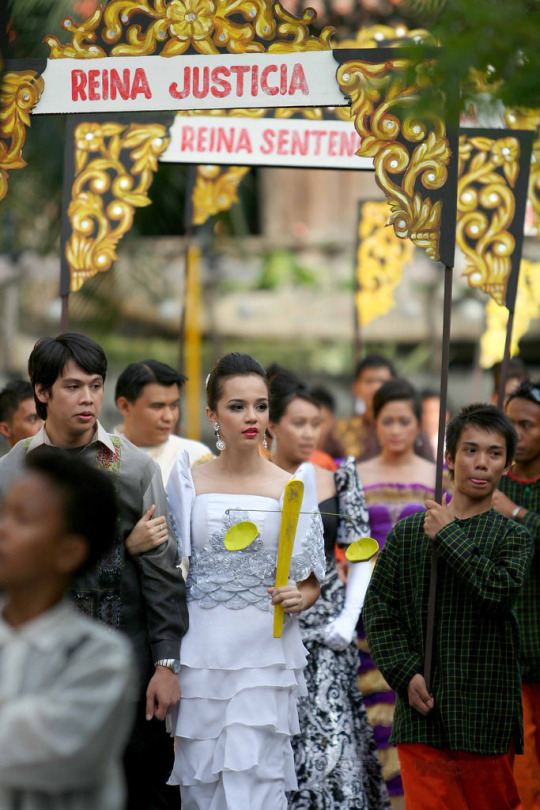
Flores de Mayo
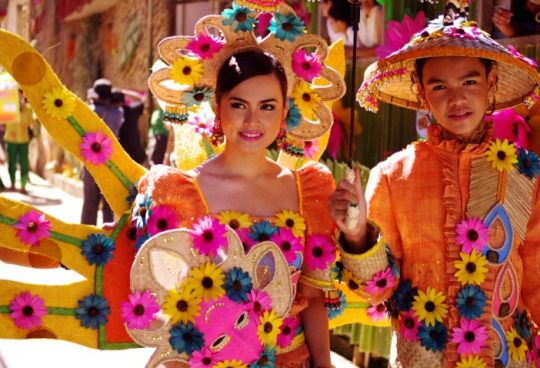
Pahiyas Festival in Lucban Quezon

The MassKara Festival of Bacolod.
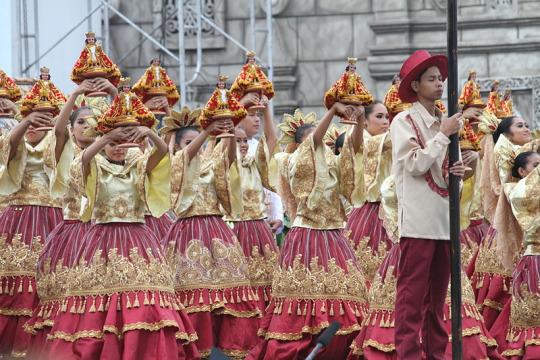
The Sinulog Festival is held to commemorate the Santo Niño
Festivals in the Philippines, locally known as fiestas, originated dating back to the Spanish colonial period when the Spaniards introduced Christianity to the country. Most Philippine towns and cities has a patron saint assigned to each of them. Fiestas in the Philippines serve as either religious, cultural, or both. These festivals are held to honor the patron saint or to commemorate history and culture, such as promoting local products and celebrate a bountiful harvest. Fiestas can be categorized by Holy Masses, processions, parades, theatrical play and reenactments, religious or cultural rituals, trade fairs, exhibits, concerts, pageants and various games and contests..
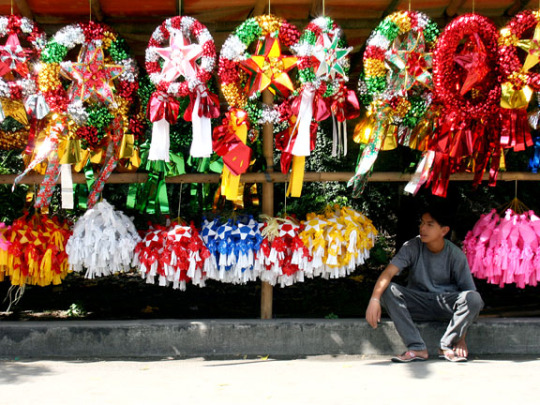
Parol (Christmas lanterns) being sold during the Christmas season

Good Friday observance in Pampanga
Heritage towns and cities
The Philippines is home to numerous heritage towns and cities, many of which have been intentionally destroyed by the Japanese through fire tactics in World War II and the Americans through bombings during the same war. After the war, the government of the Empire of Japan withheld from giving funds to the Philippines for the restoration of the heritage towns they destroyed, effectively destroying any chances of restoration since the pre-war Philippines' economy was devastated and had limited monetary supply. On the other hand, the United States gave minimal funding for only two of the hundreds of cities they destroyed, namely, Manila and Baguio....
Culture of the Philippines - Wikipedia

Ethnic Filipina in traditional costume
270 notes
·
View notes
Photo






A Thousand Thousand Islands is a series of zines detailing a fantastical version of southeast Asia, particularly the islands of Malaysia, Indonesia and the Philippines. In the real world, these islands share in many social, cultural and folkloric traditions while each region or even each island retains their own distinctions. So too with A Thousand Thousand Islands. There are eight zines as of this writing (supplemented by two zines of artwork and a volume of essays and fiction examining supernatural creatures from Malaysian folklore), each unique but part of a greater whole.
Each volume details places of interest, notable people and goods worth seeking out. Mr-Kr-Gr (2017) here is a kingdom ruled by crocodiles where travelers may not spend the night. There are random tables — this has one for type of demon idols and one for identifying traits of crocodiles. If it weren’t for the tables, honestly, you’d hardly realize the zines are for RPGs at all. They read more like wistful travel journals rather than sourcebooks. In fact, this is one of the most beguiling features of the series: it is powerfully written and full of poetry. That’s something I don’t think I can say about any other RPG book — their prose is too often preoccupied with being either weird or useful. Here Siew weaves songs that often feel personal in addition to being useful to an RPG. All the while, artist Munkao gives the poetry weight and gravity through detailed landscapes and emotive portraits. You can get as lost in his illustrations as easily as you can in Siew’s words. Between the two of them, the result is a world that is beguiling. No matter how many volumes come out, I’m left feeling like I’ve only caught a glimpse and that there is so, so much more to see.
#RPG#TTRPG#Tabletop RPG#Roleplaying Game#D&D#dungeons & dragons#Zedeck Siew#Munkao#ATTI#A Thousand Thousand Islands#Mr Kr Gr
116 notes
·
View notes
Text
A Brief Catalogue of Horse-Human Hybrids:
1. Centaur (Horse Body + 1/2 Human Body + Human Head)
The most likely origin of centaurs is the sight of of Thessalian riders on horseback, as witnessed by a civilization that had not yet learned the art. To the early Minoans, from the vantage of their own two feet, these beings galloping across the plains must have seemed monstrous hybrids, the lower half of a horse and the upper half of a man, this disparate combination of parts all somehow moving as a whole.
As a combination of man and beast, though presumably it was the human head that made decision, it was their beast-natures that were said to predominate. Centaurs were reputed as savage, prone to drunkenness, and violent. Perhaps they had a reason. “The Centauri often complain to me of plundered homes and herds stolen before their eyes [by the young Achilles],” writes Statius, “and that they themselves are driven from field and river; they devise violence and fraud, and utter angry threats." In any case, while the centauri may have been vilified, their bloodline was not: the horses of Thessaly (of whose lineage Alexander the Great’s steed Bucephalus is the most famous) were reputed to have been descended from centaur blood.
2. Chiron (1/2 Horse Body + Human Body + Human Head)
Perhaps better categorized as a variant of the centaur, Chiron was notable among his brutish countrymen for having mastered medicine, archery, prophesy, credited by Pliny as the inventor of botany and the pharmaceutical arts. This civilized element in his nature manifested physically: though he still had the hindquarters of a horse, two distinctly human feet could be seen emerging from beneath his robes. That this physical dissimilarity elevated him above other centaurs points to an unintuitive conclusion: that perhaps our civilizing capacity rests not in our heads, but in our toes.
3. Genitor (Horse Body + Horse Head + Human Toes)
Perhaps corroborating this theory is Julius Caesar’s beloved horse, Genitor, handpicked by Caesar due to its resonance with Alexander the Great’s steed, itself reputed to have extra toes. Of this magnificent creature, Suetonius writes:
He rode a remarkable horse, too, with feet that were almost human; for its hoofs were cloven in such a way as to look like toes. This horse was foaled on his own place, and since the soothsayers had declared that it foretold the rule of the world for its master, he reared it with the greatest care, and was the first to mount it, for it would endure no other rider.
4. Lusus Naturae (Horse Body + Human Head)
Various accounts of these creatures persist well up to the 20th century, hideous one-eyed creatures born from mares, all of them dying or being killed shortly after birth. While these accounts can easily be explained as cases of equine cyclopia, what is notable is the perception of humanity in their deformations. Despite only having one bulging eye, their features in contemporaneous newspaper accounts are consistently described as humanlike - the skull phrenologically suggesting a human intelligence, its malformed face curiously resembling that of our own. I have seen pictures of cycloptic horses; they are monstrous and pitiful. And yet, the descriptions from the time are unvarying. The mouth, the lips, the chin, the outline of the face - in the features of this poor dead creature we somehow see the semblance of ourselves.
5. Tikbalang (1/2 Horse Body + 1/2 Human Body + Horse Head)
A creature from Philippine folklore, the Tikbalang is said to be a humanoid creature with the head and hooves of a horse, along with disproportionately large legs. They feed on human flesh and lead travelers astray, and in this resemble an equine version of the Minotaur. They would be otherwise unmemorable aside from one notable fact: that horses are not native to the Philippines, and that legends of the Tikbalang predate any records of a horse first arriving on its shores.
As folklore has it, when Filipino natives first encountered Spanish cavalry, their reaction was not that of the Minoans, to conjoin rider and mount into one monstrous beast. Rather, the conquerors atop their steeds remained human and it was their mounts instead that were monstrous, with the body of a water buffalo, and the head of the Tikbalang.
6. Ipotane (1/2 Horse Body + 1/2 Human Body + Human Head)
The exact composition - and perhaps existence - of the ipotane is disputed. As a sort of proto-centaur mentioned sparsely in Greek mythology, they may have had the legs and hindquarters of a horse and the upper half of a human - although then again, by some accounts they had humanlike legs. How this makes them different from humans is uncertain.
The Wikipedia article, from which all other mention of ipotanes on the internet seem to be sourced, cites no sources itself save for A Greek-English Lexicon, by Liddell and Scott, ipotane (ιππότης) meaning “a horseman, knight.” Beneath it, though, the variant ιππότης λεώ��, meaning either “the horse” or “the horsemen”. It is unclear here whether the horse is the rider or the ridden - allowing that it is perhaps a horse knight riding a human, that it is only our chivalrous nature (chivalry, deriving from cheval, meaning horse) that harnesses our apish human frames.
7. Hayagriva (Human Body + Human Arms + Horse Head)
The inclusion of Hayagriva (literally, Horse-neck) on this list is controversial, as being an avatar of the Lord Vishnu, it would be incorrect to describe him as any sort of human hybrid. Still, speaking only from the perspective of iconography, we can state briefly that he is the god of wisdom and knowledge, and that his white horse’s head evokes the speed and power and intelligence for which it was once worshiped.
8. Houyhnhnm (Horse Body + Horse Head)
The Houyhnhnm are a race of intelligent horses with so rational a civilization that they knew neither wars nor lawyers nor politics, had no notion of lying, reproduced only at replacement numbers, did not mourn the dead. That they are horse in their entirety would seem to put them outside of our purview, as we are not covering other mythological horses such as the Mares of Diomedes, or Sleipnir, or so on. However, the Houyhnhnm are unique in that they only exist in comparison with the humanoid Yahoos - a violent, venal, brutish, unsanitary race who murder each other over useless shiny stones, the target of the satire being obvious. We might say, then, that the Houyhnhnm are a human hybrid conceptually, if only by negation - that it is an integral part of their composition that they exist in contrast with humanity; that they are not human, emphatically not.
9. Headless Horseman (Horse Body + Human Body + Horse Head)
With the sight of the cavalryman become commonplace, the image of the centaur lost its conceptual power. Instead, to make the mounted rider monstrous, his head was severed from its shoulders, the man made into a faceless soldier galloping across a battlefield. By uniform he might be identified as Hessian, and so a threat, but he was no longer a human being. His identity was reduced to both his headlessness - the absence of identity, of being, the absence of sight and smell and sound and voice and thought - and his horsemanship - the steed beneath him still galloping away implacably, harnessed to some phantom command.
The head - abandoned, discolored, eyes swollen shut - continues to exist, presumably, even if only defined by its absence. Should the horseman be reunited with his head we might imagine the rider shall dismount, and we will behold again a horse, and a human being. Until then, he shall ride on, monstrous and pitiful, and outside our houses hoofbeats sound.
81 notes
·
View notes
Text
The 2021 International Hrant Dink Award goes to Canan Arin from Turkey and Maria Ressa from Philipines
New Post has been published on https://armenia.in-the.news/society/the-2021-international-hrant-dink-award-goes-to-canan-arin-from-turkey-and-maria-ressa-from-philipines-78698-15-09-2021/
The 2021 International Hrant Dink Award goes to Canan Arin from Turkey and Maria Ressa from Philipines
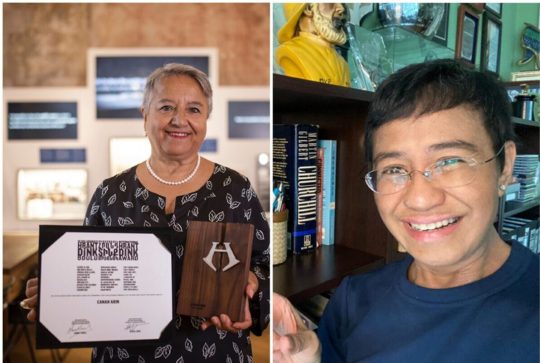

The 13th International Hrant Dink Award was presented on Wednesday, September 15th at an online ceremony streamed on the Hrant Dink Foundation accounts. This year’s awards were granted to investigative journalist Maria Ressa who defends press freedom in the Philippines under difficult political conditions and high personal risks and women’s rights activist and lawyer Canan Arın who persistently continues defending gender equality and her struggle against gender based violence in Turkey.
The award ceremony was narrated by Defne Kayalar in Turkish, and by Esra Dermancıoğlu in English languages. We thank to Mahir Günşıray and Eric Nazarian for taking part at the ceremony with their great voice overs. The ceremony was held at 23.5 Hrant Dink Site of Memory. Hrant Dink’s wife and the President of the Hrant Dink Foundation Rakel Dink welcomed the guests on behalf of the Foundation and stated that “At Hrant Dink Foundation, we stand for solidarity, goodness, equality, justice, including the right to life for the environment, nature, and human beings.” Agnes Callamard, the Secretary General of Amnesty International gave the opening speech which reflected on the struggle for human rights over the past year. Callamard ended her speech with the following words “We consider this our foremost duty: to speak up together when many may be prevented from doing so, to speak truth to power, no matter the size of power.”
Moreover, during the ceremony, people and institutions from Turkey and all around the world, who shed light to humanity with their struggles are acknowledged as the ‘Inspirations’ of 2021. Among the Inspirations of this year, there are human, environmental, refugee and women’s rights defenders from Turkey to Russia, Myanmar to the United States, Belarus to Kenya, as well as inspirational individuals and initiatives with their demands for peace, equal citizenship, democracy and justice.
Alongside the acceptance speeches of the laureates, unique musical performances were also present at the ceremony. Ezhel’s new song Mayrig [Mother], has met with the audience for the first time, Pervin Chakar, Ertan Tekin and Ayta Sözeri gave unique performances with original melodies. With Songül Öden’s narration Iraz Akçam, Ayça Bildik, Banu Fotocan, Gülçin Kültür Şahin, Zeynep Şengöz, Nesrin Uçarlar brought to life a song by Nazan Öncel giving voice to the injustices women face. The ceremony’s music supervisor Arto Tunçboyacıyan brought together musicians of all ages from Armenia; Vahagn Hayrapetyan, Gohar Hovhannisyan, Kamarama, Tmbata, Tsakhruk Ethno Music Group of Specialized Children’s Home of Kharberd, Yerevan Saxophone Quartet and Wood Winds Project have enriched the ceremony with their folkloric tunes and rich melodies.
Read original article here.
0 notes
Text
Greedy Choke Puppy - A Legend Grounded in Reality


Art work by: Laura Ferreira photography
Stories are a vital part of every human culture. They are used to explain the complex facets of human existence as well as the unusual world we live in. Monsters are a staple of our imaginations and they are typically created in stories to give the horrors of the world a tangible form. These types of stories are often told from the point of view of the victim because the storyteller is trying to warn the listener of the potential dangers. It is very rare that a story is told from the point of view of the monster, but it is intriguing every time. Greedy Choke Puppy by Nalo Hopkinson is one of these stories.
The monster in Greedy Choke Puppy is the Soucouyant, a vampiric creature that sheds its skin and transforms into a being of fire in order to hunt for young prey. The core of the story, however, is the relationship between a grandmother and granddaughter. It is established early on that the two sincerely love each other. Jacky begins the story with her Granny gently braiding her hair, which is part of their nightly routine. This tender moment is interrupted when Granny mentions her sighting of the Lagahoo, a donkey-like creature that is an omen for an oncoming death. The mood turns when Granny recalls that she saw the Lagahoo before Jacky’s mother died. It is clear that Granny loved her daughter deeply and simply wants the best for her granddaughter, but Jacky dismisses the story. Jacky instinctively knows that talking about the Lagahoo is her Granny’s way of asking her to listen to the advice she gives. Granny sees too much of Jacky’s mother in her and is trying to keep her from following that same path. Jacky chooses not to listen though.
Eventually it is revealed that Jacky is a soucouyant. She loathes the fact that she doesn’t receive the same male attention she used to when she was younger. She is desperate to find a man and settle down but that fervour ends up pushing potential partners away. This desire is what fuels her hunger for sucking the life force out of young children. Granny recognizes this in Jacky probably the same way she recognized it in her own daughter. Love is the only thing that can cool a soucouyant’s fire and desire for devouring people. Granny knows this because she is one herself and she spent a majority of her life happily married causing her to be less bloodthirsty. However, Granny also knows that there are more types of love than the romantic kind. This is why Granny pushes Jacky to find love in other places like in her work as a researcher or with her friends. Jacky needs something meaningful in her life that she loves in order to ground her in her humanity, but it is too late.
Jackie is too similar to her mother to heed her Granny’s warnings. They were both impatient in their desire and this is exemplified by the way they both ate Granny’s soup straight out of the boiling pot. Granny chastises Jackie for being greedy like her mother and this is the character trait that is eventually Jackie’s undoing. Her greed for life causes her to kill her friend's baby while she is in soucouyant form and she doesn’t seem that remorseful. This is the final nail in her coffin. Granny decides she must take preventative measures and sprinkles pepper on her human skin. This causes Jackie to be unable to return to her body and her Granny leads her outside to be killed by the rising sun. In the end, history repeats as Granny is forced to kill Jackie the same way she killed her own daughter before. The parallels in the life of Jackie and her mother are striking. It seems almost inevitable.
However, I find it strange that Granny did not tell Jackie that she was a soucouyant as well until the moment she tried to kill her granddaughter. Granny gave all her warnings cryptically and through metaphor. Perhaps if she was more direct and honest she would’ve been able to prevent such a tragedy. Maybe she felt ashamed of being a monster and saw it as a curse she passed on which led to her secrecy. If Granny embraced her true nature she could have shared the joy of being a soucouyant with her family instead of letting the fire inside them burn out of control. The cost of not sharing familial and cultural history is the harm of younger generations.
Something I find interesting though is the tale of the Soucouyant itself. There are many vampiric creatures in folklore all over the world, each with their own unique histories. The Soucouyant reminds me of the Manananggal of the Philippines and the Pontianak from Malaysia. It is also interesting that these creatures are always female. The Manananggal is a form of Aswang that is a beautiful woman by day but a bloodthirsty creature by night. She hunts by transforming her arms into bat like wings and detaching her torso from her legs. The Manananggal eats the organs of humans with her long straw like tongue, but her favorite meal is a fetus. The Pontianak is typically a woman who has died during childbirth or killed while pregnant and comes back to hunt the people who were responsible. She lures in victims with a visage of a frail beautiful woman and kills them by tearing into them with her nails and teeth. Her favorite prey are young children.
These stories of vampiric women are so interesting because they represent monstrous versions of femininity. They are all intrinsically tied to womanhood and become monstrous because of the way they deviate from it, namely by killing children. Typically stories involving them stay singularly focused on the danger they pose. Greedy Choke Puppy is different because it is grounded in reality. The two main characters are women living in the modern world and they lead full lives. Their human sides and their monstrous sides are equally on display. The story humanizes the soucouyants even as they commit heinous acts. Jacky does succumb to her monstrous nature but the reader is still able to recognize and understand the humanity within her. Granny eventually has to kill her granddaughter, but the reader understands her reasons for doing so and empathizes with the pain she must feel. It is completely unlike the traditional monster story where the monster is slain and all is well again. Jacky’s death is a tragedy that could have been prevented, not a triumph of good vs. evil. I can’t help but wonder what will happen to Granny now that all the people in the world she loved are now dead. Especially since two died by her own hand. If she is no longer tethered to her humanity by the love she felt for her granddaughter then I fear she may succumb to the same fire that consumed her loved ones.
1 note
·
View note
Text
The Story Behind ‘A Nightmare on Elm Street’
Wes Craven’s
A Nightmare on Elm Street
will celebrate its 30th anniversary on November 9… the day the original opened up in theaters and introduced sleepy teens to the terror that is, was and forever shall be Freddy Krueger.
In preparation for the milestone, Craven has been sharing a ton of information about the creation – and impact – of his incredibly influential horror franchise, including how he came up with the idea in the first place.When he wasn’t busy sharing vital Nightmare on Elm Street information on Twitter, Wes Craven was taking part in a comprehensive oral history of Elm Street for Vulture.
The primary players behind the film open up in great detail about what went in to the hiring of the cast, the creation of Freddy, and the landscape of horror in the early 1980s. With Craven coming off of Swamp Thing and The Hills Have Eyes Part II at the time, he needed to find something that was truly terrifying. And he found it in real life, so to speak.
The way Wes Craven describes it, he came up with the idea for A Nightmare on Elm Street after reading an L.A. Times article about a family that had survived the Killing Fields in Cambodia. They made it to the United States, but a young boy in the family still found himself haunted by terrible nightmares while he slept. Craven says:
He told his parents he was afraid that if he slept, the thing chasing him would get him, so he tried to stay awake for days at a time. When he finally fell asleep, his parents thought this crisis was over. Then they heard screams in the middle of the night. By the time they got to him, he was dead. He died in the middle of a nightmare. Here was a youngster having a vision of a horror that everyone older was denying. That became the central line of Nightmare on Elm Street."
The origin of Freddy Krueger? That’s awesome. And far more psychologically chilling than the parental vendetta that led to the birth of the on-screen Krueger – which also is explained in greater detail in the Vulture oral history. Burning the neighborhood child murderer in the boiler room of the local school? Vicious. The 1980s were a different time, man.
People forget how terrifying the original Nightmare on Elm Street actually was. Because over the years, Freddy became more of a huckster, or a punchline, and the Elm Street sequels went for laughs as much as they went for scares. Now’s a good time to go back and revisit Wes Craven’s film, to remember why it became a classic in the first place.
In the late 1970s to the mid 80s, more than 110 men died in their sleep. Until their quiet final moments, they were young and healthy. Their families were stunned. Investigators were bewildered. With the victims all being Asian, medical authorities named the sleep scourge “Asian Death Syndrome.” Witnesses and families called it the night terror.
The first case was reported in California’s Orange County in 1977. By the summer of 1981, 20 people had fallen victim to the night terror. Authorities and medical responders were powerless as men across the country went to sleep and never woke up.
The exotic morbidity of the night terror caught the media’s attention, with the Los Angeles Times running a string of stories on the “medical mystery” in 1981. The New York Times and newspapers in Connecticut, Florida and elsewhere devoted column inches to the sleep deaths.
Freddy Krueger’s real-life victims weren't white, middle-class teens, as played by Heather Langenkamp and Johnny Depp in A Nightmare on Elm Street. They didn’t talk in mall slang, excessively blow dry their hair or dress in early 80s-style pastels. They were mostly male and were uniformly Asian. They were refugees with poor English skills who had fled their homeland to escape a nearly genocidal conflict.
They were the Hmong, a largely pre-literate or non-literate nomadic people from the mountains of Southeast Asia. Originally from southern China, they fled what had been their homeland for thousands of years in the mid-19th century, when the Manchu dynasty labeled them barbarians. They escaped to neighboring countries, notably Vietnam and Laos.
For the Hmong who relocated to Laos, their struggle continued first under French Colonial rule before settling down for the decades of Laotian royal power. When the Vietnam War spread to Laos and Cambodia, the American supported Royal Lao government recruited the Hmong to fight the Communist Pathet Lao troops.
The Hmong gained a reputation as fierce fighters, but the war devastated their people. An estimated one-third of the Hmong population in Laos was wiped out in the conflict. Following the 1975 Communist takeover, about 100,000 Hmong fled Laos to seek asylum in Thailand. Of the Hmongs who remained in Laos, thousands were detained in reeducation camps.
Away from their home, the Hmong struggled to adapt. They were mountain farmers and warriors with a unique religion centered on animals and spirits. They farmed by growing opium and cleared fields with fire. Their written language only came into being in the 20th century; many couldn’t read it anyway.
Then they came to America and began dying in their sleep.
The first modern recorded victim of the so-called “Asian Death Syndrome" was Ly Houa, of Orange County. Before his sudden 1977 death, he had acclimated to American life and worked as a medic. An Orange County social worker who knew him told the L.A. Times said she was shocked to hear of his passing. Houa was in robust physical condition, she said, and health-conscious through his professional expertise.
By the summer of 1981, the L.A. Times reported, 20 Hmong men living in America died under the same circumstances. All were young and showed no signs of ill health until death took them in their sleep. Their families said most didn’t smoke or drink. Some witnesses said they heard troubled breathings and groans right before the death.
Only about 35,000 Hmong lived in America at the time. For the communities scattered throughout the states, the deaths were more than morbid curiosities. They were a seeming existential threat to their people. The ratio of victims to total Hmongs in the country equalled all five leading causes of death for other American men in their age group. Orange County Medical Examiner Tom Prendergast told a reporter that the mysterious incidents accounted for half of all deaths among the Hmong in America during that period.
The deaths prompted an inquiry by the Federal Center for Disease Control. They tried to contain the unexplained horror of the sleep death in the dry wording of “Sudden Unexpected Nocturnal Death Syndrome,” or SUNDS.
Officials suspected cardiac failure, but were otherwise baffled. Many blamed the stress of culture shock for refugees moving to the U.S. Minnesota Medical Examiner Dr. Michael McGee told the New York Times he thought Hmong victims in St. Paul may have been frightened to death. Hang Pao, a former Laotian general and a political leader for the Hmong, publically attributed the deaths to wartime gassing attacks. Pao, eager to turn public opinion against the Hmong’s old communists foes, said the nighttime seizures were delayed reactions to the chemical toxins the Pathet Lao used to poison villages.
No definite cause emerged. The mystery deaths peaked in 1981, when 26 men, mostly Hmong refugees from Laos, died in their sleep. A few victims of the seizures who were immediately treated by CPR survived.
While the sudden sleep death hit the American Hmong refugees the hardest, the mystery illness wasn’t limited to their people alone. The sleeping death was striking Asian men across the globe.
The disease had a long history in Asia, even in countries with no Hmong population. In 1983, the Associate Press reported that Japanese and Filipinos were dying from similar unexplained deaths. Researchers estimated that between 500 and 1,000 Japanese men, described in their 20s and 30s and healthy, died in their sleep of the condition known in Japan as “Pokkuri,” wordplay slang for death that occurs in a “snap.”
Recently uncovered research indicated it wasn’t new. CDC official Roy Baron and forensic pathologist Robert Kirscher published a report saying the attacks predated the Hmong arrival in America.
As researchers dug into the cultures with histories of SUNDS, they found something surprising. Freddy Krueger wasn’t the only killer stalking its victims through their dreams. According to Asian folklore, monsters had been preying on sleepers for years.
Hmong traditional beliefs revolve around nature spirits and ancestor worship. Among the most feared spirits is a nightmare monster known as the Dab Tsog. When Hmong fail to perform religious rituals properly, their ancestor and village spirits stop guarding them, leaving them vulnerable to the Tsog Tsuam, the crushing attack the Dab Tsog uses to press the life out of its victims.
Shelley Adler, a professor at the University of California, San Francisco, conducted dozens of field interviews among the Hmong population while researching her 2011 book Sleep Paralysis. She found people who survived SUNDS, who related tales of dream visitations from dark creatures. One interviewee said a large, hairy monster, which he likened to an American stuffed animal, accosted him in his dream. As the oversized creature set on him with claws and teeth, the dreamer was paralyzed but still able to hear voices in his home.
The Dab Tsog doesn’t haunt the dreams of Asian men alone. In the Philippines, where 43 people out of 100,000 die from SUNDS per year, the death was known as Bangungut, a Tagalog word meaning “to rise and moan during sleep.”
Filipino folklore holds that malevolent spirits called Batibat are behind Bangungut. The Batibat have the appearance of ugly, obese women and live in trees. They infest houses when the trees they live in are used to build a home. Enraged by their displacement, they wait until the homeowners are asleep they kill them in the style of the Tsog Tsaum, sitting on their victim’s chest and face to force out their life force like air from a balloon.
By the time A Nightmare on Elm Street was released in 1984, the Hmong SUNDS was slowing to a halt after its 1981 peak. It hadn’t been cured, but after taking the lives of 116 healthy young men, the night terror shuffled back into whatever dark dream it came from.
As Freddy Krueger grew increasingly cartoonish and prone to one-liners in his follow-up films, the real-life sleep deaths became less deadly. Officials like Kirschner took an optimistic assessment, postulating that stress from American culture shock caused the previous attacks. With the Hmong more used to life in the states, Kirschner said, the stress was reduced and the danger was over.
The same year, SUNDS researchers made a breakthrough. After studying the medical histories of three survivors of the attacks, medical examiners were able to identify ventricular arrhythmias as the cause of the fatal cardiac arrests. The cause of the arrhythmias wasn’t yet known, but medical authorities now knew what happened to the heart before the SUNDS deaths. In 1988, CDC pathologist Roy Gibson Parrish published a study proposing that SUNDS victims were likely carriers of hereditary defects that affected tissues that conduct electric signals. While in most cases the defects wouldn’t be a problem, they could become fatal in a body undergoing stress.
And while the Hmong were moving past their twin traumas of warfare and displacement, the night terror was attacking displaced Asian elsewhere in the globe. In 1990, two Thai men working construction in Singapore died in their sleep on the same night.
The coincidence of two SUNDS death in a single night was shocking. But they weren’t alone. About 200 Thai people living in Singapore are believed to have died in their sleep since 1983. In Sleep Paralysis, Adler quoted heart specialist Michael Brodsky attributing the deaths to stress, saying that the men were working 13-plus hour days while enduring slavery-like conditions.
2 notes
·
View notes
Text
What the myth?! Part 3. Creepy antagonists and where to find them.
Antagonists are bad and creepy. Well, it’s their nature, their role. They serve a critical role — they help the character overcome their fears, challenging him in many ways. They are heavy rocks in the river in the path of the hero. They should be highly respected and loved. Our hero wouldn’t be this strong if not them.
Maybe you remember nurses from Silent Hill, Slenderman, SCP-173, Jack Torrance from The Shining, Pennywise, Ghostface, Leatherface, Samara Morgan — all these guys which made you want to crawl under your bed.
I still remember Pale Man from Pan’s Labyrinth. Please agree with me that he’s creepy as hell! After 10 years his figure still appears in my scariest dreams sometimes.

Some of Miyadzaki’s characters are quite unsettling too. If we take Princess Mononoke, for example, all forest spirits aren’t cute, for sure.

Want to create the same impact on the player? Unique, unforgettable creature who will trigger the player’s mind every night even a few months after playing your game? The thing is — there are so many creepy characters already, so Here’s the golden question — how I create a unique antagonist. Clearly, there’s no formula for this. But I can give you a hint, where to take inspiration: guess what, Japanese myths again.
Rokurokubi — creepy female spirits with an elongated neck. The head is floating like it’s a genie from the bottle of a cobra ready to attack. There are two types of rokurokubi — the first type can stretch its neck, the second type is with a freely flying head. They usually attack at night and drink blood. Interestingly, there are similar creatures in Indonese, Malaysian, Thai, South American, Philippine mythologies.
Inugami — a spirit of a dog. To cause this spirit, an unbelievably cruel ritual was performed, which was even popular during the Heian period: Take a starving dog. Cut off its head. → An aggressive spirit will appear which can be used against your enemies.

Ittan-momen — a piece of cloth that flies around at nights and suffocates people while wrapping around them. I heard that some parents in Japan are telling stories to their children stories about Ittan-momen spirits to make sure won’t get home too late. (If I was one of these kids, I would never leave the house, never ever).

Kamikiri — a spirit that appears suddenly and cuts the hair off. This spirit may appear in the fox (kitsune), insect or human-like form.
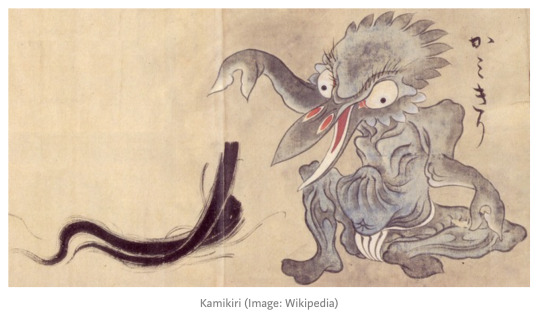
Nure-onna — a spirit with a woman’s head and a reptilian body. They live close to water and eat humans. In some tales, this spirit is mean and devious — it gives a baby to the victim, which after some time turns out to be a stone. The victim is going underwater by the stone heaviness and is eaten by another queer spirit Ushi-Oni (nice teamwork, by the way).

Ushi-oni — a spirit that basically looks a giant spider with a head of a bull. They live at beaches and attack people who walk on beaches. And, yes, they spit poison and eat humans. Overall these spirits have a difficult personality; some of them even have wings. Also, it preys on human shadows, so the person dies slowly.

Nekomata — a cat spirit that can shapeshift into humans, speak Human language, cursing people, attacking people together with a wolf pack. The creepy thing is that it has hair like Samara from The Ring.

Jorogumo — a spirit that looks like a charming woman at day, but turns into a gigantic golden-black spider at night which preys on humans. Lives near water.
Bake-kujira — a ghost skeleton whale. It is accompanied by strange birds and fish. Can’t be killed by harpoons. It brings curses and misfortune.
These are only a few of the monsters of Japanese myths. I highly recommend digging deeper into the topic and explore all the mindblowing creatures coming from the imagination of Japanese folk. And remember: there are numerous cultures and folklore to explore.
#story#storytelling#japanese#japanese myth#spirited away#spirit#yokai#japanese yokai#myth#mythology#writers on tumblr#writer#writblr#writing#writers#narratology#narrative#gamer#game blog#scriptwriting#english
0 notes
Text
Performance Task: INFOGRAPHIC

Act of Heroism: A Critique Paper of the Comic “Pedro Penduko” by Francisco V. Coching
Pedro Penduko is a Filipino comic book character portrayed as a folk hero or superhero, created by National Artist for Literature Francisco V. Coching and appear on Liwayway Magazine. It was published in 1954. The original plot of the story of Pedro Penduko centered the characteristics of heroism. It was Pedro who is a simple, carefree country boy who can always be counted to lend a hand to his neighbors. When Marina arrives from Manila, Pedro and Antonio were both attracted by her beauty, but it is Pedro who catches her attention. One day, the barrio is attacked by Tirong and his bandits, who kill Don Julian and take Amparo. Pedro goes after Tirong and challenges him. Antonio tries to shot Pedro, but hits Tirong instead. Marina and Amparo were reunited while Tirong’s men were imprisoned. Then, Pedro Penduko is hailed as the town hero. As time went by there is slight changes to the original plot theme of the comic, but still it focuses heroism. This plot is what we are used to know nowadays. It is the adventure of Pedro searching for his father upon encountering extraordinary creatures unique in Philippine folklore. Pedro Penduko in the work of Francisco Coching is really reflects us as a Filipino. It is because we valued heroism so much to the point that we become warriors to our own battles in our life and an instrument to others. This means that we Filipinos stay strong no matter how many obstacles will come to our life and in every calamity that may arrive, we remain still and fight for it because after every storm has a rainbow, like what happened during the landfall of Typhoon Yolanda last 2013, we stand still and hoping for recovering for the better future. In addition, Heroism is what marked our Philippine history. Because of Heroism, we become who we are right now, we gain independence from the hands of those who colonized us through the persona of our national heroes. These evidences proved that the theme of the comic which is heroism is relevant to us Filipino for it shaped the values we have today and motivates us to go forward in our life. The comic Pedro Penduko also reflects our unique Filipino culture and Traditions for it highlights our ethnical Filipino folklore. It is our superstitious belief of having monster creatures or Gods or Goddesses living and embodied with a certain object like in trees, seas, and sculpture and that we must have the responsibility to respect and protect all God-made beings and objects. The mythical creatures present in the comic were the tikbalang, tiyanak, kapre, mananaggal, etc. The work of Fernando Coching promotes a preservation of traditions and beliefs because this Philippine folklore can be passed down to generation through the platform of comic. And this has something to do with preserving our identity as a Filipino. Artistically, this comic was produced at year 1954 and it was during this era that technology was not yet introduced that is why visual art during this time were mainly rely to manpower. Looking at the cover page of the comic, it implies that the art was made manually and it is not that advance compare to the visual arts we have today. Although it was not appealing, the elements of arts were still present in the artwork. The space portray in the artwork was a negative space because the shape is enclosing and at the same time various lines were present specifically curved, straight, vertical, horizontal which formed the figures in the artwork. Since the work is a comic art work, shape is necessary because it requires a bubble shape to place the conversation between characters and a text box to insert the caption of every scene in the comic. Also the form is relevant to have a 3D effect in the artwork. The color and value of the artwork was also present and very evident because there are parts that were darkened in order to give emphasis and to contrast with the image. The color also matches to the characteristics of the object that it portray because the leaves are green, the tree trunk is brown and the person’s skin color is also brown which justify him being a Filipino. However, the texture was not that solid due to the lack of technology available to create an embedded effect.. But overall the artwork was nice in such that we are not able to recognize the value of the artwork because we are now exposed and introduced to modern and contemporary artwork. However, if we are living during the date of its publication then this is one of the best pieces of artwork we are probably have. Remember that Comic is a combination of two forms of art namely Literature and Picture art because comic contains visual arts and literary art. This is such a heroism act for the artist because he is taking the risk of combining two art forms into one platform through comics.
An Art of War: A Critique Paper of the Comic “Lapu- Lapu” by Francisco V. Coching
The indomitable love for his country and the realistic illustration of Francisco V. Coching was shown in his comic entitled “Lapu-lapu”. The storyline of the comic started in Mactan where there were two tribes which are led by Lakan Sula and on the other side by Lakan Dupil with his son Lapu-Lapu and his daughter Yumina. Yumina falls in love with a Spaniard, causing problems in the family. Eventually Lakan Dupil dies and is succeeded by Lapu-Lapu, who is destined to go down in history as the famous chief who defeats the Spaniards in the battle of Mactan. Looking at his work, even if the plot was fictional, majority of the scenes are still based on actual events and it was mesmerizing how Francisco Coching detailed a description of our tribal origins, he stated that we are a trademark of a resurgent and resilient brown race situated in the archipelagic territory of the South East Asia. One of the theme or idea presented in the comic was the realistic depiction of tribal wars. Tribal wars was present in the comic because of an element called conflict Man vs. Man present in the plot which adds color to an artwork because a plot will not be exiting without a problem or conflict within or between characters in the story. Tribal wars are still exists in the present especially to our country. Particularly, that the Philippines is diverse in cultures which somehow depicts our cultural and religious differences to some regions in the country. For example in Mindanao, here in Mindanao we have our Christians and Muslims brothers and sisters, conflicts between this groups are still existing nowadays because of the people’s sense of superiority and lack of understanding. In order to attain peace, war is not a solution but rather love and respect. We must accept and understand each other’s differences so that we can have a mutual understanding on both sides and remove that barrier that divides us because we are one as a nation. It was exclaimed in the comic that “Even if this diverse culture is also marred by the regionalistic factions and tribal wars, it's still good to think that we are not just a generous and accommodating race easy to be exploited for we once stood by existing laws under the watchful eye of Bathala with our instinctual beliefs and ethics inherited from our ancestors that remained intact and prompted us to unite for the protection of our land, our children, and our right to live. Those who wanted to colonize and control us will have to think twice because in the end, we will always fight for what we believe is our birthright in our own native land.” This idea from the comic proved to us that our national hero did not fail us in fighting our freedom in the character of Lapu-Lapu who fought for the country to gain independence from the hand of the Spaniards. The idea of war before was about fighting for the country which is an act of nationalism at patriotism. However, war nowadays is not the same idea as war before because war nowadays was rooted to the superiority and greediness of power and wealth. Looking at the physical aspects of his artwork or in other words the cover page of the comic, we can see that it was an art that was drawn in to create figures and portray an image. Since this comic was published in 1954, advancement of technologies used in making an artwork were not yet introduced that is why making an artwork like this is done manually but still the elements of arts were present in the artwork. Lines in the artwork serve as the backbone of the art because through the combination of different kinds of lines that were joint together in a certain point, there is an image formed. For example in the artwork, the picture of Lapu-Lapu was formed because of the presence of different lines such as curved, diagonal, vertical and horizontal lines. Also line makes up shape that is why shape is present in the artwork evident is the textbox where some information was in placed. In the image, most shapes are in a form of abstract. These shapes detailed the texture of an image and at the same time it contributes in highlighting space because as the object is nearer, the shape is larger but on the other hand if it is in distant, the shape is far from the point of reference. To add some life in the artwork, the element of color and value was applied. The color used in the background is somehow gives the viewer an idea on the setting and it influences mood. Also the color used by the artist matches the kind of object it portray, for example, the skin color is brown, the hair is black and etc. In addition, there were portions in the artwork that were darkened in order to give emphasis and it highlights shadows in the image to give some realistic effect. The size of the object seen in the image was very relative and was scaled according to proportion and also the principle of balance was observed in the image because the number of objects in the different side of the portrait was equal however it was not symmetrical balance. There is also emphasis present specially to the text that it gives emphasis by having a color different from the other object and also the character Lapu-Lapu which is enlarged to give emphasis. Overall the artist was very brave to apply all these element in just one part of his work, how much more to the remaining pages of the comic. Francisco V. Coching is truly a national artist.
An Action of Art: A Critique Paper of the Comic ‘’Berdugo’’by Francisco V. Coching
A filipino comic book entitled Berdugo depict the story of a man who puts criminal to death, created by National Artist for Literature Francisco V. Coching. This filipino comic book was published in 1959. The storyline of the story evolves the story of Francisco Coching as he was known as an amazon warrior that involves fast- paced action. One day Don Ubaldo Mondiego and his son Leo love to go hunting around their hacienda and they accidently hit Tusa in the leg and insist on letting her stay in the big house to be treated by a doctor, against the wishes of her jealous boyfriend Mando. When Don Ubaldo is killes on one of their hunting excursion, Leo is suspected. Don Ubaldo’s last will and restament divides his property equally between his son Leo and his adopted son Tauro, but the lawyer who reads the will also ends up dead. Eventually Leo and Mando are confronted by the real ‘berdugo’, Tauro, who killed Don Ubaldo, the doctor, and the lawyer in order to claim the inheritanc. They are saved just in time by Leo’s dog Diablo, who attacks Tauro, cursing him to lose his balance and fall into a ravine. Fransico Coching published this work when he was 20 through the outbreak of World War II, then he uses this as an inspiration to produce Berdugo as one of his comic book. He realize the importance of how an individual protect in the midst of danger that takes risk of ones life. It ends the story of how they use their power to fight back against their enemy that violates the rule that someone does a wrong move Through the scene of this comic it is been said that ‘pag pinukol ka ng bato ay gantihin mo ng tinapay’ this sayings state that when someone leads you in the wrong way give him the best shot of what you could offer in your life that make his life disgraceful enough to face the reality of what his been doing. This makes us strong as a person when someone shows insecurity and hate around us such us inferiority complex, stereotyping and expectations, as we live in a society full of judgement and hatred that despise our reputation as a normal person, with this it affects the way how ones life can be a better example that plays a vital role in engaging of how society works. One example right now in the Phillipines is the Death penalty that involves the punishment of execution, administered to someone legally convicted of a capital crime. This penalty must be executed to a person who are using prohibited drugs, against human rights and many more. Death penalty aims to execute person who are committed to as a suspect of killing and rape which is against human rights but this penalties as well is against human rights. There are many methods of death penalty but it is still inhuman. Otherwise, if the death penalty will be not approve, where is the justice in our country? I understand that the death penalty is against human rights, but how about those people that can be a victim of rape, and these possible suspect of heinous crimes can have a better life. If these is the only and possible way to lessen the criminals, to make them fear of making crimes. But I only wish that the current government will support every people that resides in this country, so that we can prevent unexpected number of people that may be executed to such penalty. Support in a way of, giving some lectures every month or maybe once a year of what are the available work a person can enter to be busy with, free scholarship for some unfortunate children that cannot afford to enter any school. Death penalty is against every human’s right yet we must think of the positive results of what can bring these to us in connection to this government should play a vital role to be able to cope up and encourage to those people who doesn’t really know the impotance of the law, the pros and cons, and the process of how will it affect our society and also to our country. This make the solution makes an impact of how one deliver the and have the ability to use our voice to speak up and bring torch for the future generation. By considering the forms of art in the comic book it contain an art theory elements focus on analyzing the art aspect of the comic, its visual components of color is not that attractive because it is black and white as we also consider the year it was published wherein technology is not technical, its shape and lines in every dialogues is convenient to the reader that it is clear to see the words and symbols. Its principles of art includes of how he balance the distribution of sketches and drawings, it is an informal balance, presented design are not equally distributed so this type is asymmetrical since this is a comic book it has a lot of edges that doesn’t fit when it is eqaully distributed. The movement of every art forms creates rhythm that the repetition of certain elemens produce a pattern, it creates a certain flow and may leads viewers eyes more attractive, this work also has a harmony of different parts that produce an overall positive impact or effect, the unity of artwork and the presence of its parts that is well arranged. And its scale and proportion is relative to the size of parts in its every page of comic book that has a relationship of elements. This variety of forms means that artist uses to organize elements within the work of art.
1 note
·
View note
Text
Phillipines
Host Country Report
INTRODUCTION: When traveling anywhere unfamiliar or out of the country it is very important to know the most abundant amount of details possible about the country you are sojourning to. I chose the Philippines as my country to sojourn to because of the knowledge my grandparents possess (being natives of the Philippines) and because it is a part of my family’s culture that I have not yet experienced. I began to search and collect pictures, videos, blogs, and even music videos consisting of the island’s appearance, diversity, and any culture shocks that may pertain to me whenever I get the chance to travel here. The Philippines makes for a very beautiful place to travel and vacation. It is off the cost of Asia and is surrounded by the Indian and Pacific Ocean. My collection contains many items such as pictures of the beaches and the
the variety of landscapes such as mountains, beaches, and amazing cities such as Manila. It’s very easy to get lost in the amazing views and forget about the culture within the Philippines. Manila, which is the capital, is a very extravagant city as stated by my grandparents and is very beautiful to view at night. Though the country may contain much poor and homeless, it still possesses the sights and are that any individual would want to see in person.
LANGAUGE/RELIGION: The Philippines is closest culturally to Latin America and is even considered as being a south pacific country. Many view the Philippines as being directly related to Chinese/Japanese/Korean, but these countries/cultures do not have much of an impact on the Philippines. There are many similarities to countries such as Puerto Rico with how the standard of living is and the language. The Philippino natives use a language known as Tagalog. This is a unique and diverse language that has ties with Spanish. Though Tagalog is the main language of the Island, English is also dominant. This results from the many citizens that are planning or have already joined the Military such as my grandfather. Shockingly the Philippines is the only Christian nation in/ around Asia. More than 86% is Roman Catholic, 6% belong to nationalized Christian Cults, 2% Protestant denominations, 4% Muslim, and 2% following non-western beliefs/practices. ( http://asiasociety.org/education/religion-philippines)
POLITICS/GOVERNMENT: The Political system of the Philippines is very similar the United States and involves a great amount of the Roman Catholic-Christian religion. There is a president which currently is Rodrigo Duterte. In this country, the President is the head of state and the head of government. Though this form of government exists, many provinces and regions of the Philippines lack and form of local government due to the abundance of poverty and poor living conditions surrounding the island. Articles on President Duterte and how he has killed off most of the drug cartel and violent hate- crimes has caused great controversy within the Philippines. This informed me as to how the government handles any crime. Though it may seem like a very great idea and logic, many disagree with his gruesome form of punishment involving killing any individual seen interacting or distributing of drugs. Most of these crimes happen within the three largest cities known as Quezon City, Makati, and Manila (which is the capital). Much of these crimes also occur because of the abundant amount of poor citizens. Much of the Philippines is rundown, leaving many homeless. Many areas do not even possess running water and the restrooms consist of holes in the ground and toilet paper is not provided. As described from Pinoymoneytalk.com (https://www.pinoymoneytalk.com/sec-abcde-percentage-population/), the high social class known as the A/B class only make up for 1% of the population while class C/D/E make up for the rest of the population.
GENDER ROLES: In the Philippines gender roles are very set in stone. They have changed from the traditional beliefs where men hold most power and work while the women stay home and garden and provide for the family within the house. Marriage has changed drastically but the belief is that both the male and female should at least be between the ages of 20-22 when marrying and couples who marry should have well-established jobs and can take care of their families/ education of siblings. Though this has changed, men still hold most power and freedom and there are still improvements in equality that have still not been put into effect.
MEDIA/FILM/NEWS/MUSIC: With all the culture and beliefs comes the differences that set the Philippines apart from other countries such as media, cuisine, and even demeanor. The Philippines is like any other country and has television and news. The main television stations are ABS-CBN-2, GMA 7, TV5, Studio23, etc. These range from soap operas and sitcoms to sports such as Studio23. This ties into the music industry that ranges from singers such as Claire Dela Fuente and rappers such as Callalily. These are among the top artist in the Philippines, but traditional Tagalog singing is what is mostly listened to by the older generations while the newer style rap is listened to by teens and young adults. For the film industry, the natives appreciate any form of cinema as an art. They believe it reflects their culture and the beliefs of any viewers. One of the most popular forms of film is horror. These are among some of the scariest movies around the world such as the Chinese horror films and are very breathtaking, keeping any viewers on the edge of their seat. Yanggaw is one of the scariest being about a folklore monster Aswang, which is a shape shifting vampire. When it comes to any news or top stories needing to be reported on any local/world news, stars, or even recently released movies, The Manila Times and The Phillipino Star are among the most popular and influential newspaper industries in the Philippines. http://www.manilatimes.net/news/
(Aswang- From the movie Yanggaw) https://www.youtube.com/watch?v=bKndsmjpxP8
CUISINE: Food is a great part of the culture and even consist of roasting entire pigs’ at large gatherings. https://www.youtube.com/watch?v=lTbjML8CDkI. This derived from the diverse geography and consist of some of the most simple ways of cooking such as boiling, steaming, grilling, and stewing. They are heavily influenced from centuries of trading with Spain, China, France, and even the United States. This food documentary from BBC goes into great detail about the customs and traditions of the cuisine such as the roasting of a full-size pig as I stated before.
Another traditional dish known as “Halo-Halo” is very known world-wide. This consist of multiple fruits, red beans and even chick peas and can be found here in the U.S. as well at many Philippino restaurants such as Jollibee. This video explains and shows a clip from Anthony Bourdain’s television show while he visits the Philippines https://youtu.be/lj6zyqFCc-8.
The average individual may consume up to 5 meals a day which may be smaller in portion. This begins with an early breakfast followed by a 10 am snack, Lunch, another snack, and dinner. They like to end the day with sweets such as Halo-Halo, fruit, or even caramel. With all this food consumption comes the way of purchasing. In the Philippines, they use the Peso. The value is different than that of the United States, but there is no difference in the style of purchase or how traditional their currency is.
GREETING/POSTURE: From being Philippino I know what they emphasize and take great respect towards when it comes to posture, dress, and greeting each other. Philippino’s are known for their hospitality and caring for one another no matter the circumstances. This consist of very soft handshakes but once someone is known or comfortable it may change to kissing on the cheeks along with a pat on the back or shoulders. Family is everything and respect is nothing to mess with. It is very disrespectful to raise your voice or shout at anyone. When having a conversation, they often say “yes” as opposed to “no” due to the emphasis on staying very humble and positive. “Thank you” is said as “Salamat” and “po” is added after if speaking to an elderly or in a formal environment.
CONCLUSION: Overall, the Phillipines is a very beautiful country that you should try and travel to. The diverse geography and culture makes for a great experience that no one would want to miss out on. With this guide, there should be no problems (besides the bit of culture shock you may experience) when staying here. The cuisine is what most would enjoy but try to experience everything possible because you may never get the chance again.
REFERENCES:
http://traveltips.usatoday.com/food-culture-philippines-17408.html
http://www.aenet.org/family/filmhistory.htm
http://www.gov.ph/about/gov/
http://www.manilatimes.net/news/
http://cgacadthephilippines.weebly.com/blog/gender-roles-in-the-philippines
http://asiasociety.org/education/religion-philippines
http://asiasociety.org/education/religion-philippines
0 notes